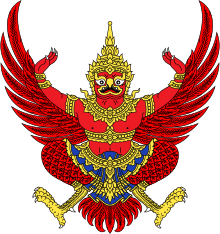Sukhothai Kingdom
| Kingdom of Sukhothai | ||||||||||
| อาณาจักรสุโขทัย | ||||||||||
| ||||||||||
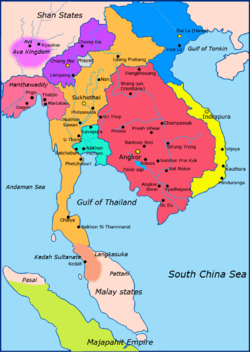 1300 Orange: Sukhothai Kingdom Light Blue: Lavo Kingdom Red: Khmer Empire Yellow: Champa Blue: Dai Viet Purple: Lanna | ||||||||||
| Capital | Sukhothai (1238–1347) Phitsanulok (1347–1583) | |||||||||
| Languages | Sukhothai dialect | |||||||||
| Religion | Theravada Buddhism | |||||||||
| Government | Feudalism | |||||||||
| King | ||||||||||
| • | 1249–1257 | Sri Indraditya | ||||||||
| • | 1279–1299 | Ramkhamhaeng | ||||||||
| • | 1347–1368 | Lithai | ||||||||
| • | 1571–1583 | Ramesuan | ||||||||
| Historical era | Middle Age | |||||||||
| • | Liberation from Lavo Kingdom | 1238 | ||||||||
| • | Expansions under Ramkhamhaeng | 1279–1298 | ||||||||
| • | Became Ayutthayan tributary | 1378 | ||||||||
| • | Became Personal union with Kingdom of Ayutthaya | 1448 | ||||||||
| • | Became Vassal of Taungoo Empire | 1563 | ||||||||
| • | became part of the Kingdom of Ayutthaya | 1583 | ||||||||
| ||||||||||
| Today part of | | |||||||||
Part of a series on the |
|---|
| History of Thailand |
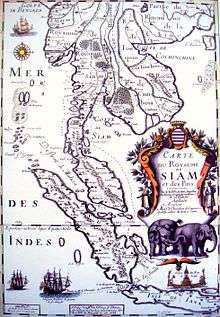 |
|
Legendary Suvarnabhumi Central Thailand Dvaravati Lavo Supannabhum Northern Thailand Singhanavati Ngoenyang Hariphunchai Southern Thailand Pan Pan Raktamaritika Langkasuka Srivijaya Tambralinga Nakhon Si Thammarat Sultanate of Pattani Kedah Sultanate |
| History |
|
Sukhothai Kingdom Ayutthaya Kingdom Thonburi Kingdom Rattanakosin Kingdom Military period Democratic period |
|
Regional history |
|
|
The Kingdom of Sukhothai (Thai: สุโขทัย;[Note 1] pronunciation) was an early kingdom in the area around the city Sukhothai, in north central Thailand. The Kingdom existed from 1238 until 1583. The old capital, now 12 km outside of New Sukhothai in Tambon Mueang Kao, is in ruins and has been designated as a UNESCO World Heritage historical park.
Etymology
Sukhothai is from Sanskrit sukha (सुख "happiness") + udaya (उदय "rise, emergence"), meaning "dawn of happiness". Alternatively Sukhothai means Sukho ('Happiness' in Sanskrit) + Sthan ('Place' in Sanskrit) >>> Thhai (Place as a derived meaning) resulting in the meaning as Place of Happiness
History
Liberation from Lavo
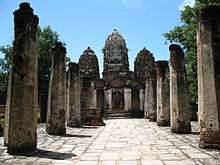
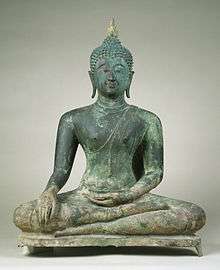
Prior to the 13th century, Tai kingdoms had existed in the northern highlands including the Ngoenyang Kingdom of the Tai Yuan people (centred on Chiang Saen and the predecessor of the Lanna Kingdom), and the Heokam Kingdom of the Tai Lue people (centred on Chiang Hung, modern Jinghong in China). Sukhothai had been a trade centre and part of Lavo (present day Lopburi), which was under the domination of the Khmer Empire. The migration of Tai people into the upper Chao Phraya valley was somewhat gradual.
Modern historians stated that the secession of Sukhothai (once known as Sukhodaya)[2] from the Khmer empire began as early as 1180 during the reign of Pho Khun Sri Naw Namthom who was the ruler of Sukhothai and the peripheral city of Si Satchanalai (now a part of Sukhothai Province as Amphoe). Sukhothai had enjoyed a substantial autonomy until it was reconquered around 1180 by the Mon people of Lavo under Khomsabad Khlonlampong.
Two friends, Pho Khun Bangklanghao and Pho Khun Pha Mueang revolted against the Khmer Empire governor of Sukhothai.[3]:195–196 Khun, before becoming a Thai feudal title, was a Tai title for a ruler of a fortified town and its surrounding villages, together called a mueang; in older usage prefixed by pho (พ่อ) "father",[4] (comparable in sound and meaning to rural English Paw). Bangklanghao ruled Sukhothai as Sri Indraditya – and began the Phra Ruang Dynasty - he expanded his primordial kingdom to the bordering cities. At the end of his reign in 1257, the Sukhothai kingdom covered the entire upper valley of the Chao Phraya River (then known simply as Menam, "Mother of Waters," the generic Thai name for rivers.)
Traditional Thai historians considered the foundation of the Sukhothai kingdom as the beginning of their nation because little was known about the kingdoms prior to Sukhothai. Modern historical studies demonstrate that Thai history began before Sukhothai. Yet the foundation of Sukhothai is still a celebrated event.

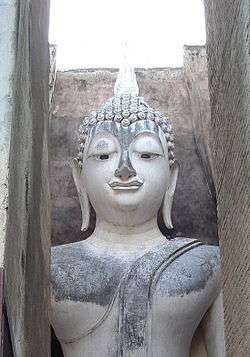
Expansions under Ramkamhaeng
Pho Khun Ban Muang and his brother Ram Khamhaeng expanded the Sukhothai kingdom. To the south, Ramkamhaeng subjugated the kingdom of Supannabhum and Sri Thamnakorn (Tambralinga) and, through Tambralinga, adopted Theravada as state religion. Traditional history described the extension of Sukhothai in a great fashion and the accuracy of these claims is disputed. To the north, Ramkamhaeng put Phrae and Muang Sua (Luang Prabang) under tribute.
To the west, Ramkhamhaeng helped the Mons under Wareru (who is said to have eloped with Ramkamhaeng’s daughter) to free themselves from Pagan control and established a kingdom at Martaban (they later moved to Pegu). So, Thai historians considered the Kingdom of Martaban a Sukhothai tributary. However, in practice, such Sukhothai domination may not have extended that far.
With regard to culture, Ramkhamhaeng requested the monks from Sri Thamnakorn to propagate the Theravada religion in Sukhothai. In 1283, the Thai script was invented by Ramkamhaeng, formulating into the controversial Ramkamhaeng Stele discovered by Mongkut 600 years later.
It was also this time that the first relation with Yuan Dynasty was formulated and Sukhothai began sending trade missions to China. The well-known exported good of Sukhothai was the Sangkalok (Song Dynasty pottery) – the only period that Siam produced Chinese-styled ceramics and fell out of use by the 14th century.
Decline and domination of Ayutthaya
By the beginning of the fourteenth century, the Thai of Sukhothai controlled most of present-day Thailand. Only the eastern provinces remained under Khmer control.[3]:223 After the death of Ramkhamhaeng, the Sukhothai tributaries broke away. Ramkhamhaeng was succeeded by his son Loethai. The vassal kingdoms, first Uttaradit in the north, then soon after the Laotian kingdoms of Luang Prabang and Vientiane (Wiangchan), liberated themselves from their overlord. In 1319 the Mon state to the west broke away, and in 1321 Lanna placed Tak, one of the oldest towns under the control of Sukhothai, under its control. To the south the powerful city of Suphanburi also broke free early in the reign of Loethai. Thus the kingdom was quickly reduced to its former local importance only.
In 1349, the armies from Ayutthaya kingdom invaded and put Sukhothai under her tributary.[3]:222 Then, in 1378, King Luethai had to submit to this new power as a vassal state.[5]:29–30
In 1424, after the death of Sailuethai, Paya Ram and Paya Banmeung the two brothers fought for the throne. Intha Racha of Ayutthaya intervened and further divided the kingdom between the two. Their sister had married to Borommaracha II of Ayutthaya and produced a son, Prince Ramesuan. When Borommapan died in 1446 without any heirs, the throne passed to Ramesuan or Trailokanat. Ramesuan was also crowned as the King of Ayutthaya in 1448, thus began the personal union between the Kingdom of Sukhothai and Ayutthaya.
The Silajaruek of Sukhothai are hundreds of stone inscriptions that form a historical record of the period. Among the most important inscriptions are Silajaruek Pho Khun Ramkhamhaeng (Stone Inscription of King Ramkhamhaeng), Silajaruek Wat Srichum (an account on history of the region itself and of Sri Lanka), and Silajaruek Wat Pamamuang (a Politico-Religious record of King Loethai).
Fall of Sukhothai
After the Battle of Sittaung River in 1583, King Naresuan of Phitsanulok (and crown prince of Ayutthaya) forcibly relocated people from the cities of Phitsanulok, Sukhothai, Phichai, Sawankhalok, Kamphaeng Phet, Phichit, and Prabang to the Southern Central plain,[6] due to the war with the Burmese and an earthquake. After crown prince Mingyi Swa of Burma died in single combat at Don Chedi in 1592, these cities were restored, but not as an independent kingdom, but as provinces within the Ayutthaya Kingdom.
The kings of Sukhothai
Sukhothai in Thai historiography

Sukhothai story was narrated into Thailand's "national history" in late 19th century by King Mongkut, Rama IV, as a historical work presented to the British diplomatic mission. King Mongkut is considered as the champion of Sukhothai narrative history, based on his find of the Number One Stone Inscription, the 'first evidence' telling the history of Sukhothai.[7]
From then on, as a part of modern nation building process, modern national Siamese or Thai history comprises the history of Sukhothai. Sukhothai was said to be the 'first national capital',[2] followed by Ayutthaya, Thonburi until Rattanakosin or today Bangkok. Sukhothai history was crucial among Siam/ Thailand's 'modernists', both 'conservative' and 'revolutionary'. Rama IV (King Mongkut) said that he found 'the first Stone Inscription' in Sukhothai, telling story of Sukhothai's origin, heroic kings such as Ramkhamhaeng, administrative system and other developments, considered as the 'prosperous time' of the kingdom.
Sukhothai history became important even after the Revolution of 1932. Researches and writings on Sukhothai history were abundant.[8] Details derived from the inscription were studied and 'theorised'.[9] One of the most well-known topics was Sukhothai's 'democracy' rule. Story of the close relationship between king and his people, vividly described as 'father-son' relationship,[10] the 'seed' of Thai Democracy. However the change in ruling style took place when later society embraced 'foreign' tradition, Khmer's Angkor tradition, influenced by Hinduism and 'mystic' Mahayana Buddhism. The story of Sukhothai became the model of 'freedom'. Jit Bhumisak, a 'revolutionary' scholar, also saw Sukhothai period as the beginning of Thai people's liberation movement from foreign ruler, Angkor.
During military rule, from 1950s, Sukhothai was placed in Thai national curriculum. Sukhothai became model of 'father-son' rule, described as 'Thai Democracy', free from 'foreign ideology'; Angkorian tradition compared to communism. Other Sukhothai aspects were investigated seriously, such as commoner and slave status, and economic situation. These topics, said, were on stage of ideological thoughts fighting during the Cold war and civil insurgency times in 1960-1970s.
Notes
- ^ "สุโขทัย" (Sukhothai) is the modern spelling. Archaic spellings include "ศุโขไทย"[11] (Sukhothai) and "สุกโขไท"[12] (Sukkhothai). Sukhothai is sometimes romanised as Sukhodaya.[2]
References
- ↑ "Seated Buddha in "Maravijaya"". The Walters Art Museum.
- 1 2 3 Cœdès, G. (1921). "The Origins of the Sukhodaya Dynasty" (PDF). Journal of the Siam Society. Siam Heritage Trust. JSS Vol. 14.1b (digital): 1. Retrieved 17 March 2013.
The dynasty which reigned during a part of the 13th and the first half of the 14th centuries at Sukhodaya and at Sri Sajjannlaya, on the upper Menam Yom, is the first historical Siamese dynasty. It has a double claim to this title, both because it cradle was precisely in the country designated by foreigners as "Siam" (Khmer: Syam; Chinese Sien, etc.), and because it is this dynasty which, by freeing the Thai principalities from the Cambodian yoke and by gradually extending its conquests as far as the Malay Peninsula, paved the way for the formation of the Kingdom of Siam properly so called.
- 1 2 3 Coedès, George (1968). Walter F. Vella, ed. The Indianized States of Southeast Asia. trans.Susan Brown Cowing. University of Hawaii Press. ISBN 978-0-8248-0368-1.
- ↑ Terwiel, Barend Jan (1983). "Ahom and the Study of Early Thai Society" (PDF). Journal of the Siam Society. Siamese Heritage Trust. JSS Vol. 71.0 (digital): image 4. Retrieved 7 March 2013.
khun : ruler of a fortified town and its surrounding villages, together called a mu'ang. In older sources the prefix ph'o ("father") is sometimes used as well.
- ↑ Chakrabongse, C., 1960, Lords of Life, London: Alvin Redman Limited
- ↑ Template:อ้างหนังสือ
- ↑ Lingat, R. (1933). "History of Wat Pavaranivesa" (PDF). Journal of the Siam Society. Siam Heritage Trust. JSS Vol. 26.1c (digital). Retrieved 17 March 2013.
In 1837 King Phra Nang Klao made Prince Mongkut Abbot o£ Watt Pavaranivieca, situated close to wall, ih the northern part of the city. This monastery had been founded about ten years previously by Prince Cakti, who had been raised to the rank of Second King on the ascension of Phra Nang Klao, his nephew (1824-1832).
- ↑ Bradley, C.B. (1909). "The Oldest Known Writing in Siamese; the inscription of Phra Ram Khamhaeng of Sukhothai, 1293 A.D." (PDF). Journal of the Siam Society. Siam Heritage Trust. JSS Vol. 6.1b (digital). Retrieved 17 March 2013.
- ↑ "Epigraphical and historical studies, nos. 1-24 published in the Journal of the Siam Society from 1968-1979"--Pref. Includes bibliographical references. Subjects: Inscriptions, Thai. Notes: English and Thai; some Pali (in roman).
- ↑ Sarasin Viraphol (1977). "Law in traditional Siam and China: A comparative study" (PDF). Journal of the Siam Society. Siam Heritage Trust. JSS Vol. 65.1c (digital). Retrieved 17 March 2013.
- ↑ "พระราชพงษาวดาร ฉบับพระราชหัดถเลขา ภาค 1" [Royal Chronicle: Royal Autograph Version, Volume 1]. Bangkok: Wachirayan Royal Library. 1912. p. 278.
- ↑ Thailand's Inscriptions Database (2006). "จารึกวัดศรีชุม ด้านที่ 1" [Wat Si Chum Inscription: Face 1] (in Thai). Bangkok: Princess Maha Chakri Sirindhorn Anthropology Centre (Public Organisation). Retrieved 19 November 2014.
External links
| Wikimedia Commons has media related to Sukhothai Kingdom. |
| — Royal house — Sukhothai Dynasty Founding year: 1238 | ||
| Preceded by Lavo Kingdom |
Ruling Dynasty of the Kingdom of Sukhothai 1238-1583 |
Succeeded by Ayutthaya Kingdom |
